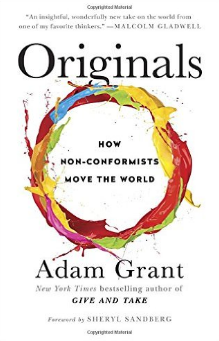 I recently read “Originals: How Nonconformists Move The World” by Adam Grant. Below are the quotes I found most interesting. If you like them, buy the book here.
I recently read “Originals: How Nonconformists Move The World” by Adam Grant. Below are the quotes I found most interesting. If you like them, buy the book here.
“After finding that disadvantaged groups consistently support the status quo more than advantaged groups, Jost and his colleagues concluded: “People who suffer the most from a given state of affairs are paradoxically the least likely to question, challenge, reject, or change it.”” (6)
“Justifying the default system serves a soothing function. It’s an emotional painkiller: If the world is supposed to be this way, we don’t need to be dissatisfied with it.” (7)
“The hallmark of originality is rejecting the default and exploring whether a better option exists.” (7)
“Although child prodigies are often rich in both talent and ambition, what holds them back from moving the world forward is that they don’t learn to be original. As they perform in Carnegie Hall, win the science Olympics, and become chess champions, something tragic happens: Practice makes perfect, but it doesn’t make new.” (9)
“Entrepreneurs who kept their day jobs had 33 percent lower odds of failure than those who quit. If you’re risk averse and have some doubts about the feasibility of your ideas, it’s likely that your business will be built to last. If you’re a freewheeling gambler, your startup is far more fragile.” (17)
“Polaroid founder Edwin Land remarked, “No person could possibly be original in one area unless he were possessed of the emotional and social stability that comes from fixed attitudes in all areas other than the one in which he is being original.”” (19)
“Having a sense of security in one realm gives us the freedom to be original in another.” (19)
“The biggest barrier to originality is not idea generation – it’s idea selection.” (31)
“Simonton finds that on average, creative geniuses weren’t qualitatively better in their fields than their peers. They simply produced a greater volume of work, which game them more variation and a higher chance of originality.” (35)
“If you want to be original, “the most important possible thing you could do,” says Ira Glass, the producer of This American Life and the podcast Serial, “is do a lot of work. Do a huge volume of work.” (37)
“Across fields, Simonton reports that the most prolific people nto only have the highest originality; they also generate their most original output during the periods in which they produce the largest volume.” (37)
“Many people fail to achieve originality because they generate a few ideas and then obsess about refining them to perfection.” (37)
“When artists assessed one another’s performances, they were about twice as accurate as managers and test audiences in predicting how often the videos would be shared.” (42)
“Our intuitions are only accurate in domains where we have a lot of experience.” (51)
“Physicists, accountants, insurance analysts, and chess masters – they all work in fields where cause-and-effect relationships are fairly consistent. But admissions officers, court judges, intelligence analysts, psychiatrists, and stock brokers didn’t benefit much from experience. In a rapidly changing world, the lessons of experience can easily point us in the wrong direction. And because the pace of change is accelerating, our environments are becoming ever more unpredictable.” (53)
“The more successful people have been in the past, the worse they perform when they enter a new environment. They become overconfident, and they’re less likely to seek critical feedback even though the context is radically different.” (54)
“When people sought to exert influence but lacked respect, others perceived them as difficult, coercive, and self-serving. Since they haven’t earned our admiration, we don’t feel they have the right to tell us what to do, and we push back.” (65)
“Francis Ford Coppola observed, “the way to come to power is not always to merely challenge the Establishment, but first make a place in it and then challenge and double-cross the Establishment.”” (66)
“Most of us assume that to be persuasive, we ought to emphasize our strengths and minimize our weaknesses. That kind of powerful communication makes sense if the audience is supportive. But when you’re pitching a novel idea or speaking up with a suggestion for change, your audience is likely to be skeptical. Investors are looking to poke holes in your arguments; managers are hunting for reasons why your suggestion won’t work. Under those circumstances, for at least for reasons, it’s actually more effective to adopt Griscom’s form of powerless communication by accentuating the flaws in your idea.” (69)
“The first advantage is that leading with weaknesses disarms the audience.” (69)
“If you’re perched at the top, you’re expected to be different and therefore have the license to deviate. Likewise, if you’re still at the bottom of a status hierarchy, you have little to lose and everything to gain by being original. But the middle segment of that hierarchy – where the majority of people in an organization are found – is dominated by insecurity.” (82)
“In the long run, research shows that the mistakes we regret are not errors of commission, but errors of omission. If we could do things over, most of us would censor ourselves less and express our ideas more.” (91)
“If you’re feeling pressured to start working on a creative task when you’re wide awake, it might be worth delaying it until you’re a little sleepier.” (97)
“People have a better memory for incomplete than complete tasks. Once a task is finished, we stop thinking about it. But when it is interrupted and left undone, it stays active in our minds.” (99)
“In the majority of circumstances, your odds of success aren’t higher if you go first. And when the market is uncertain, unknown, or underdeveloped, being a pioneer has pronounced disadvantages.” (108)
“The originals who start a movement will often be its most radical members, whose ideas and ideals will prove too hot for those who follow their lead.” (117)
“Simon Sinek argues that if we want to inspire people, we should start with why. If we communicate the vision behind our ideas, the purpose guiding our products, people will flock to us. This is excellent advice – unless you’re doing something original that challenges the status quo.” (124)
“For insiders, the key representative is the person who is most central and connected in the group… But for outsiders, the person who represents the group is the one with the most extreme views.” (128)
“The most promising ideas begin from novelty and then add familiarity.” (136)
“Instead of assuming that others share our principles, or trying to convince them to adopt ours, we ought to present our values as a means of pursuing theirs. It’s hard to change other people’s ideals. It’s much easier to link our agendas to familiar values that people already hold.” (140)
“Rob Minkoff explains: If it’s not original enough, it’s boring or trite. If it’s too original, it may be hard for the audience to understand. The goal is to push the envelope, not tear the envelope.” (141)
“Predicting personality is more challenging with only children than with children who have siblings. Like firstborns, only children grow up in a world of adults and identify with parents. Like lastborns, they are protected fiercely, which leaves them “free to become radicals themselves.”” (162)
“Reasoning communicates a message of respect… it implies that had children but known better or understood more, they would not have acted in an inappropriate way. It is a mark of esteem for the listener; an indication of faith in his or her ability to comprehend, develop, and improve.” (164)
“Parents of highly creative children had an average of less than one rule and tended to “place emphasis on moral values, rather than on specific rules.”” (164)
“When we praise children for their intelligence, they develop a fixed view of ability, which leads them to give up in the face of failure. Instead of telling them how smart they are, it’s wise to praise their effort, which encourages them to see their abilities as malleable and persist to overcome obstacles.” (169)
“The most inspiring way to convey a vision is to outsource it to the people who are actually affected by it.” (221)
“People are inspired to achieve the highest performance when leaders describe a vision and then invite a customer to bring it to life with a personal story. The leader’s message provides an overarching vision to start the car, and the user’s story offers an emotional appeal that steps on the accelerator.” (222)
“Merely knowing that you’re not the only resistor makes it substantially easier to reject the crowd. Emotional strength can be found even in small numbers.” (225)
Liked the quotes? Click here to buy the book

